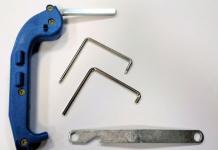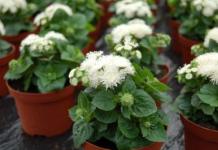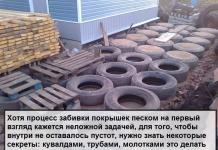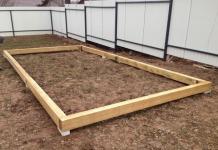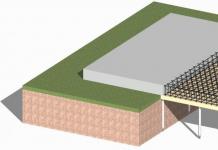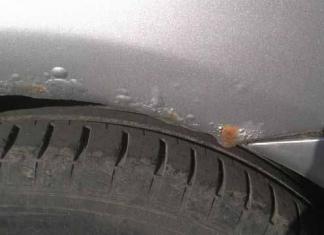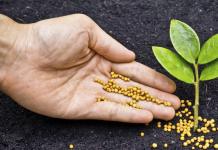The ageratum plant, which is not very difficult to plant and care for in the open field, is a favorite flower of people who love to see bright cut bouquets indoors. A native flower from North America, outwardly very reminiscent of an aster. These plants are able to keep fresh for a very long time when cut. Ageratum characteristics and description can be found both on the Internet and in the literature on floriculture and horticulture for specialists and amateurs.
- 1 For a plant, it is important to choose a place that will be as illuminated as possible. This flower normally tolerates shade only 2 hours a day. The rest of the time, it is desirable to stay in direct sunlight for the ageratum, even if the weather in the region is very hot and dry.
- 2 An important rule in growing ageratum from seedlings or seeds is the absence of drafts. It is preferable to choose an open place, which will be protected by a green fence in the distance. This will allow you to simultaneously give the plant maximum light and shelter it from the winds.
- 3 Despite the fact that the plant is not very whimsical to the soil, it is advisable to choose the most light and non-acidic soil for it. You should not enrich the earth too much with fertilizers, since in this case all the forces will be spent on the formation of foliage, and flowering will not be so noticeable.
- 4 Avoid the presence of a large number of stones in the soil, and do not over-moisten it before planting. Otherwise, the root system may rot and the plant will die, without having time to please with its beautiful buds.
- 1 Moderate but plentiful watering is the key to active flowering of the plant. The culture loves moisture very much, but it does not tolerate its excess in the soil. Watering the plant is necessary as the soil dries. You can do this often, but at the same time use a little water, it is also allowed to water the ageratum less often with a large amount of liquid in order to wet the entire earthen lump. In a hot and arid climate, the flower needs abundant moisture.
- 2 Try to remove weeds from the soil around the bushes after each watering. Do this carefully so as not to damage the not yet fully formed root system of the plant, if we are talking about young seedlings.
- 3 Weeding the soil is one of the main factors in the formation of beautiful bouquets of flowers. Weed the earth after each watering (after about 1-2 days, when it dries a little). This will provide the roots with breath and will not rot.
- 4 Plant bushes respond well to formation. Thanks to the correct pruning, the bushes can be given the most bizarre views - from spherical to elongated upwards. Even pruning contributes to a more active and lush flowering of the plant.
- 5 So that the ageratum does not grow up, but forms a lush crown of leaves and flowers, you should periodically pinch it. And you need to do it at a young age. During pinching, it is important to leave at least 5 leaves on the shoots of the plant. Then the bush will bloom for a long time and magnificently.
- 6 Proper application of fertilizers to the soil is another important aspect of caring for ageratum. It is necessary to introduce minerals into the soil no more than three times a week. In this case, you can limit yourself to mullein or chicken manure. But any manure must be diluted with water.
- Blue ball (Blueball). Compact hemispherical bush reaches 20 cm in height. It is densely covered with slightly pubescent shoots. The inflorescences are collected in baskets with a diameter of 6 cm. The color of the petals is bluish-lilac.
- Alba (Alba). This white ageratum is valued for its unpretentious nature and milky-snow shade of petals. Miniature, spherical bush reaches 20 cm in height. Inflorescences exude a strong, pleasant aroma.
- Ageratum blue mink. The flowers of the variety are painted in a rich pale blue hue. They are collected in dense inflorescences with a diameter of 6-8 cm, which densely cover a compact, spherical bush 25 cm high. Baskets are very fluffy, in appearance they resemble mink fur, which is why the name of the variety appeared.
- Pink fields (Purple Fields). The hybrid variety is distinguished by an unusual purple color of the petals. Spherical bushes of the plant reach 30 cm in diameter and 25 cm in height. The inflorescences cover the plants so densely that the foliage of the crop is almost invisible.
- Red Sea. Variety with rich purple-red and ruby \u200b\u200binflorescences. The shrub reaches 40 cm in height. It blooms at the end of May, and pleases with its numerous buds until frost. Suitable for cutting.
- Bavaria. This ageratum is distinguished by two-color petals. In the central part they are painted in white tones. And at the edges, their color becomes a rich blue color. The shrub reaches 30 cm in height.
- peat;
- sand;
- humus.
- Pour the soil into the boxes.
- Mix seeds with sand. This will help evenly distribute the material over the surface of the soil.
- Spread the seeds of the flower. But at the same time, do not cover them with soil, but lightly press them to the ground.
- Spray the planting with water from a spray bottle.
- Cover the crops with plastic wrap or glass.
- Put the greenhouse in a warm place.
- Dig holes, the depth of which is 2-3 cm more than the volume of the earthen coma of seedlings.
- Moisten the soil, and transplant the seedlings, along with an earthy clod, into the pits.
- Fill the voids with soil and lightly compact.
- Water the planting again and mulch the soil surface with peat.
- regular watering;
- top dressing;
- soil loosening;
- pruning.
- Spend the first application of fertilizer a week after planting the ageratum open ground.
- Feed the crops a second time when buds are developing.
- Cut the shoots 10-15 cm long. Make the lower cut at an oblique angle.
- Moisten the substrate and make holes in the soil with a pencil.
- Treat the cut of the cuttings with "Kornevin", and bury them in the soil.
- Cover the seedlings with glass jars or cut plastic bottles.
- Put the plants in a bright place with a temperature of 20-22 ° C.
- "Blue Ball" (Blue ball). Low-growing variety, bush height up to 15 cm. Inflorescences are loose, consist of several lilac-blue small baskets up to 1 cm in size. Early variety, begins to bloom in June.
- "Blue Magic" (Blue magic). Medium-sized variety, up to 30 cm high. The size of lilac-blue baskets reaches 1.7 cm. The variety is early, many-flowered inflorescences.
- "Tetra Vary" (Tetra Veri). Compact bush with dense blue inflorescences.
- "Little Dorrit" (Little Dorrit). Undersized variety. Hemispherical bushes reach a height of 20 cm. An early variety with light blue baskets up to 1.3 cm in size.
- "Summer Snow" (Snowy summer). White-flowered tall variety. The bush grows up to 45-50 cm.
- "Red Sea" (Red Sea). The color resembles a viburnum berry. Height - up to 20 cm in good light (in the shade it grows higher, to the detriment of flowering).
- "White Ball" (White ball). A medium-sized variety with a bush height of up to 30 cm. The flowers are small, pure white. Flowering is plentiful.
- "Pink Ball" (Pink ball). As the name implies, it has a bright pink color.
- "Gold rush" (Gold rush). One of the most unusually colored varieties is rich yellow.
- "Fire Pink" (Fiery pink). Dark pink inflorescences with a lilac tint. The total height of the bush is about 25 cm.
- "Blue Mink" (Blue mink). The color of the flowers is a rare, deep blue. The leaves also have an unusual bluish tint.
- "Blue Horizon" (Blue gave). The height of the variety varies from 10 to 50 cm. The shade of flowers is rich, pink-lilac.
- "Hawaii White" (White Hawaii). Compact variety of ageratum with snow-white small flowers.
- "Atlantic" (Atlantic). Violet-blue color, bush height up to 20 cm.
- "Purple Fields" (Purple fields). Unusual pink-purple color, plant height up to 25 cm. The bushes are not erect, but half-spread on the ground.
- "Ocean" (Ocean). Light blue baskets, the plant under normal conditions reaches 20 cm.
- Sufficient lighting. Remember that in the shade the ageratum blooms too rarely or does not bloom at all, and its shoots are too stretched, trying to catch the sun's rays.
- As mentioned above, the use of nitrogen fertilizers negatively affects the formation of buds, therefore, for top dressing, it is better to use potassium-phosphorus compounds, which are called “For beautiful flowering”.
- Prevent flowering and too heavy soils. The best substrate for agetum is light, loose earth with neutral acidity.
- "Alba";
- "Tetra Veali";
- "Blue Perfection";
- "Ocean";
- North Sea.
- beginning of March - South of Russia;
- the end of March - the Volga region and the middle lane;
- early April - Siberia, Urals.
- strobi- the price is about 3000 rubles per bottle of 200 g, it copes well with root rot, which ageratum is prone to.
- Topaz- the price is 120 rubles per 10 ml, distributed as a means of preventing fungal diseases.
- Quadris- the price is about 3500 rubles per liter, it has a low degree of toxicity.
- Maksim- the price is about 1700 rubles per liter, it actively fights fungi such as Ascomycetes.
- Prepare a container.
- Carry out soil preparation work. Combine sand, earth and humus. Treat it with a fungicide.
- Fill the container with prepared soil.
- Water generously.
- Spread the seeds evenly over the surface. When using granules (prepared according to the method indicated above), landing occurs at a depth of 5 mm. If ordinary seeds are used, it is not necessary to deepen, just lightly press the soil.
- Cover the container with a transparent lid.
- after 7-8 days after the first pick;
- after 7-8 days after the second pick;
- in 10-12 days before landing in open ground.
Show all
plant varieties
There are many varieties of ageratum, each of which is distinguished by its color, the shape of the buds and the decorativeness of the green mass. Plants can be both large and small, but they all have one thing in common - the beauty of the buds and their durability. It is required to dwell in more detail on the varieties of culture.
Ageratum blue is one of the most common varieties. The flowers of this plant are distinguished by a special saturation of shade, although they are not too large in size. Ageratum Blue mink is a similar variety, only its buds are smaller and lighter. In height, the ageratum Blue mink reaches only 15-20 cm, but stands out among all the others with delicate bluish-lavender flowers.
Ageratum Blue Ball is also considered a compact plant, although it is already slightly higher than the previous variety - it reaches 20-25 cm. This species differs in rather dense inflorescences of a pale blue hue. Pink ball - the variety is the same, only it has pink inflorescences.
Ageratum White (Alba) - a variety characterized by snow-white flowers that blind your eyes right. The bush of white ageratum is not very large - about 20 cm in height, the inflorescences on it are dense and very beautiful, somewhat reminiscent of the bride's wedding dress.

Ageratum Houston is a type of culture that combines all the plants described above, plus a few more varieties. It is a collection of all ageratums of small sizes with medium-sized, but tightly adjacent to each other buds in inflorescences. Houston's Ageratum is a mixture of Mexican plants in a wide variety of vibrant colors.
Site and soil preparation
For ageratum, planting and care in the open field are determined by the choice of a suitable place for the plant, as well as soil that will fully satisfy the needs of this chic bush. If we talk about growing, ageratum first requires proper planting, so it is necessary to consider its main subtleties. So:
Compliance with such simple recommendations will provide the plants with the necessary conditions for the further development and formation of dense bright inflorescences, regardless of how this crop is supposed to be planted in open ground.
Successful cultivation of ageratum from seeds at home and in the open field is equally effective. But gardeners still prefer to plant this plant more in their gardens or vegetable gardens, so it is necessary to dwell on this process in more detail.

Germination from seed
If ageratum is grown from seeds, when should they be planted in the ground? This is the most frequently asked question by gardeners. Experts assure that it is best to do this in early March, when there are no more severe frosts at night. However, if we are talking about growing a plant from seeds at room conditions, followed by a pick of rooted flowers, then you can start sowing seeds as early as January. There are many varieties of this plant, but the planting material for all is almost the same.

To grow a healthy ageratum from seeds, you should prepare a suitable substrate. It is best to take humus, sand and peat in equal parts, mix everything thoroughly and moisten so that the soil becomes loose. Prepare wooden boxes or peat pots, pour the substrate into them. Ageratum seeds can not be soaked.
In a box or pots, make shallow grooves, spill with warm water, put the seeds there and sprinkle with loose soil on top. You can moisten the ground with water from a spray bottle.
The box is covered with foil. Seedlings will appear in about 10 days, after which the plants can be taken out into the air. If the greenhouse is located right on the site, start opening it more often so that the flower gets used to the surrounding climate. Moisten the soil as it dries out, sprinkle the sprouts with a new substrate to form healthy roots.

Picking seedlings into separate peat pots or directly into the ground to a permanent place is done when the plants already have several leaves, and the stem has become quite powerful. The first time after picking, the ageratum should be watered with any complex fertilizer.
Planting cuttings
When propagating the ageratum by cuttings, it is important to choose the right weather - when the temperature will be kept at 21 ° C, and there will be no severe frosts at night. Planting ageratum in the ground should be rooted. The holes for it are not prepared too deep, since excessive planting in the ground can lead to rotting of the stem.

In ageratum, seedlings require good drainage from expanded clay, a little chicken manure or dry leaves. Such organic matter will serve as a sufficient nutrient medium for the near future. Immediately after planting, cover the ageratum with a film. It will be possible to remove it only when the plant is fully strengthened, and the temperature is above zero both day and night.
If you plant ageratum flowers correctly in open ground, then this is already half the battle. But care for ageratum is just as important as proper fit. They follow this beautiful plant no less than other inhabitants of the garden. In this case, some subtleties should be taken into account:

All of the above tips will help grow healthy ageratum plants on the site, which will delight for a long time with their bright color and decorative leaves. If we talk about growing, the flower is not very whimsical to care for.
Possible difficulties
Like any garden flower, ageratum, which is easy to care for, is not protected from pests and fungal diseases. And although, unlike fruit crops, a flower is more resistant to negative effects, it also needs prevention and periodic treatment as needed. It is necessary to dwell on these issues in more detail.

Ageratum diseases
The most dangerous disease of ageratum is cucumber mosaic. It manifests itself in the fact that white and yellow spots appear on the leaves. Soon, in the absence of appropriate treatment, such spots attract aphids, which finally destroy the ageratum.

Unfortunately, there is currently no effective treatment for this disease, if it is a severe lesion. You just need to remove the diseased bush from the soil. If the plant is not badly damaged, you can treat it with Bordeaux mixture.
Another dangerous disease is root rot. It affects and destroys almost all plants with the wrong watering regimen. At the initial stage, rotting of the roots practically does not affect the condition of the plant. But with the progression of the disease, the ageratum literally begins to wither: the leaves wither and turn yellow, the flowers are not particularly bright, the buds form weak or do not tie at all.
If signs of root rot are found, then it is imperative to remove the ageratum from the soil and carefully examine the root system. With a strong defeat, most likely, it will not be possible to save the plant. If only a small part of the roots is rotten, then they are removed, and the cuts are treated with charcoal. After this, it is better to plant the ageratum in another place to avoid re-infection.

Typical pests
One of the most common insects that can cause significant damage to the ageratum is the whitefly. As a rule, it affects the leaves, after which white or yellowish spots remain on them, outwardly very reminiscent of a mosaic disease. As a method of dealing with the whitefly, special oils are used, which are sprayed with ageratum bushes. Such minerals can be purchased at any garden store. The treatment interval is from 1 to 2 weeks. This can also be done for preventive purposes. But before the procedure, do not forget to remove all affected leaves and stems.
As for slugs and bears, they do not spoil this plant so often. If, nevertheless, there are too many pests on the site, then it is better to use baits in a timely manner, thanks to which it will be possible to reduce their number in a relatively short time and thereby protect the plants if possible.
For ageratum, the description and cultivation rules of which today can be found in many reference books for flower growers, it is important to do everything on time - picking, watering, weeding and pruning. Then beautiful inflorescences with colorful buds will not keep you waiting long and will delight both in the flower bed and cut in a vase indoors. When choosing for yourself a certain variety of ageratum, remember that almost all types of this plant are unpretentious in content. Cultivation and care will not be difficult, even if there is a desire to arrange several varieties in a flower bed at once.
Delicate ageratum is in great demand among gardeners. And this is not surprising, because the plant has an attractive appearance and lush, long flowering. In addition, unpretentious character is a quality for which ageratum is valued. Planting and care in the open field, plant features and problems with its cultivation - you will learn this and much more from our material.
Description
Ageratum is an attractive representative of the Astrov family. In its natural environment, this flower grows in North and Central America, as well as in Eastern India.
Translated from Latin, the name of the plant means "ageless". And this name is the best fit for ageratum, because the buds retain their freshness and attractive appearance for a long time even after cutting.
The plant is a compact shrub, up to 60 cm high. It has emerald green leaves, which, depending on the variety, are triangular, oval and diamond-shaped.
Small flower buds are collected in baskets with a diameter of 1-1.5 cm. They exude a pleasant aroma, and are painted in white, blue or pink tones. Baskets, in turn, are collected in complex corymbose inflorescences, densely covering the bush and giving it the appearance of a colorful ball.
The flowering period begins in late May - early June, and lasts almost until frost. After the buds, small boxes are formed on the plant, each of which contains a huge number of seeds. Moreover, the seed retains its germination capacity for 3-4 years after harvest.
Although ageratum is a perennial plant, in our climatic conditions it is grown as an annual. The flower gets along with other plants, and it is used in creating compositions with other cultures. The best "neighbors" are marigolds, calendula and snapdragons.

flower varieties
In nature, there are 60 plant species. In addition, breeders have bred many varieties of ageratum. The following varieties have gained popularity among flower growers:
Ageratums - flowers for the garden, which will decorate the backyard. In addition, they are unpretentious, and even a novice gardener will grow them.

Growing a plant
There are two ways to propagate ageratum - growing from seeds and cuttings. Let's start with the first method. Since the plant is thermophilic, it must be grown in seedlings. Keep in mind that 2-2.5 months will pass between sowing and planting seedlings in open ground. Therefore, work should begin in mid-late March.
As for the soil, a store-bought peat mixture is suitable for growing ageratum from seeds. Or make the soil yourself. To do this, mix in equal proportions:
Be sure to disinfect the soil before planting the ageratum. To do this, fill the soil with boiling water, then spread the soil in a 5-centimeter layer on a baking sheet. Bake for 20-30 minutes at 70-90°C.
In addition, you can disinfect the soil in a steam bath. To do this, prepare a large container and lay an iron grate or bricks on the bottom. Pour water below the level of the stones. Pour the soil into a canvas bag, and place it on a stand. Steam the earth in a steam bath for 1.5-2 hours.
We grow seedlings
Flower seeds do not need preparation. But still, before sowing, hold them in a weak solution of potassium permanganate. This will protect the material from bacteria and fungi. How to sow:
In order for the seeds to germinate, they need to create comfortable conditions.

seedling care
At the stage of seed germination, it is important for crops to provide high humidity. To do this, do not allow the earthen coma to dry out and spray the soil from the spray gun daily. In addition, it is recommended to keep the greenhouse in a room with a temperature of 20-25 ° C. Do not forget to ventilate the seedlings daily, and remove condensation from the glass.
As soon as the sprouts hatch, which occurs in the second week after planting, reduce moisture, remove glass or film and transfer the planting to a well-lit place.
During this period, it is desirable to maintain low humidity (25%). But it is not recommended to allow the soil to dry out, so periodically spray the seedlings from the spray bottle.
After two pairs of leaves appear on the seedlings, dive the plants and transplant them into separate cups. Do not delay this event. After all, if the sprouts begin to interfere with each other, then in the future this will affect the appearance of the shrubs.
At this time, it is recommended to feed the sprouts, because the lack of nitrogen and minerals will affect their strength and growth. For these purposes, use complex preparations. But in no case do not exceed the dosage - this will have a bad effect on the future flowering of crops.
Two weeks before planting seedlings in open ground, begin to harden seedlings. To do this, take the seedlings to fresh air for a couple of hours. But give up this event when it gets cold.
When to plant ageratum in open ground? The best time will be the end of May. You can plant earlier, but only if the risk of morning frost disappears.
Location selection

Ageratum is a flower that prefers well-lit places. And at the slightest shadow, the shoots of the plant are strongly extended and the shrub itself loses the shape of a compact ball. Keep this in mind when choosing a location for a flower garden.
As for the soil, light loams and sandy loams with a slightly alkaline or neutral reaction are preferred for culture. Do not plant flowers on too fertile land. Here the plant will give a lot of leaves and shoots, but it is difficult to achieve lush and friendly flowering from it.
The plant does not like stagnant moisture at the roots, so you should not choose wetlands and lowlands for a flower garden. In this case, the root system of the culture will rot.
Ageratum: planting and care in the open field
The plant is planted by transshipment. It is recommended to maintain a distance of 20-25 cm between tall varieties, 15 cm is enough for dwarf varieties. How to plant seedlings:
When planting seedlings, never use fresh manure. This will lead to intensive growth of shoots and leaves. At the same time, the buds will appear late, moreover, there will be few flower stalks on the plant.

culture care
Ageratum flower is an unpretentious plant. But that doesn't mean he doesn't need attention at all. To achieve long and friendly flowering, provide the culture with the right care, consisting of:
Watering
The ageratum flower tolerates drought well and has a negative attitude to waterlogging. Therefore, it is recommended to water the crop after the topsoil dries out.
Please note that flowers growing on light sandy soils need frequent moisture. But if the plants "live" in heavy loam, then they should be watered much less frequently.
top dressing
To achieve long flowering, do not forget to fertilize the plant. Keep in mind that preparations containing nitrogen cannot be used for ageratum. Therefore, use phosphorus and potassium complex compounds. It is recommended to feed the flower twice a season:
If the color of the leaves and inflorescences has faded, then fertilize the plant a third time. But use complex mineral preparations for this.

pruning
Be sure to remove faded shoots. This will improve the appearance of the plant. In addition, the removal of dead branches stimulates the emergence of new flower stalks. To prevent the branches from stretching, carry out shaping pruning. To do this, leave a few internodes on the shrub. Then the culture will take the form of a ball.
Soil loosening
Do this after every watering. Then you will provide air access to the roots of the plant. This will protect the culture from diseases.
Reproduction by cuttings
In autumn, choose the strongest and most beautiful shrub, transplant it into a pot and bring it indoors. Of course, you will not be able to achieve flowering from a culture at home. But in the spring you will have something to cut green cuttings for further rooting.
After transplanting, keep the ageratum flower in a cool place. This will reduce the stress of the procedure. In the future, put the plant in a well-lit place and provide the culture with moderate watering. Once a month, feed the flower with a complex mineral fertilizer. But make only a quarter of the dose indicated on the package.
Start cuttings 1.5 months before planting the crop in How to conduct the event:
Within 3 weeks, provide the cuttings with regular watering and airing. After the shoots give roots, remove the greenhouse. A month later, when new branches appear on the cuttings, transplant the plants into open ground.

Diseases and pests
Ageratum is endowed with strong immunity. But with insufficient care or violation of the rules of agricultural technology, this flower can get sick. Most often, flower growers are faced with gray rot. This disease is treated with Bordeaux mixture.
The situation is much worse if the plant is affected by root rot. The disease is incurable, so at the first sign, destroy the affected shrub. In addition, be sure to remove the soil in which the culture grew, because it contains pathogens that can infect other plants.
The flower is often attacked by the whitefly - a moth-like butterfly. To destroy the pest, treat the shrub with Aktara or Tanrek insecticides. The spider mite is no less dangerous for the ageratum. You can recognize a harmful insect by a thin web that braids plants. For treatment, use acaricides "Akarin" or "Nissoran".
In autumn, when very few plants bloom, you can see the bright inflorescences of ageratum. Its flowers, like light fluffy clouds, float above the dense green of the stems and leaves. Delicate pompoms of flowers are painted in a variety of shades: blue, cream, lilac, lilac. Ageratum is very beautiful and is able to decorate any corner of the garden.
This genus of ornamental plants belongs to the aster family (lat. Asteraceae). From the Greek language, the name of the genus (lat. Ageratum) can be translated as "ageless", and it is quite justified: long flowering, from June to the very frosts, allowed ageratum to become an important crop in floriculture and landscape design. In addition, even in the cut, such flowers do not fade for a long time, remaining fresh for several days and even weeks. For this quality, people call ageratum long-lived or long-flowered.
The homeland of the plant is America (North and Central), as well as East India. There, the flower is found in the wild, and in our country it is grown as a potted and ornamental crop when creating flower beds or borders. The magnificent ageratum is valued for its abundant flowering, rich color, variety of colors and is grown everywhere in Russia.
A semi-shrub or herbaceous plant in its homeland manifests itself as a perennial crop, while in our country it is grown as an annual. Occasionally in greenhouses you can find a perennial ageratum.
The appearance of ageratum is familiar, perhaps, to everyone. There are many stems, they are pubescent with simple hairs, branch strongly, stand straight or rise from the ground, up to 10–55 cm tall. Where the shoots touch the ground, adventitious roots grow. The leaves are rich green, triangular or diamond-shaped, serrated or serrate at the edges. The leaves are petiolate, and the petioles of the lower leaves are longer than those of the upper ones; on the edge of the shoots they are practically sessile.
The flowers are small, collected in inflorescences - medium-sized baskets about 1 cm in size, which look like small powder puffs. Several baskets are collected in complex shields up to 10 cm in diameter. The stigmas of flowers and perianths have the same color - pink, blue, lilac, white, purple, and in the bud state they seem brighter than after blooming. Flowers have a fragrant smell. Flowering lasts 4–5 months until frost hits. The fruits begin to ripen unevenly from August, as individual baskets fade. The fruits are small wrinkled achenes 0.6 mm wide, up to 3 mm long, black in color, with a small white membranous tuft. Seeds are wedge-shaped, five-sided, light (up to 7 thousand pieces in 1 gram). They show good germination even after 4 years.
The plant is photophilous, can grow in partial shade, prefers heat. As an annual crop, it propagates by seeds, while only 80% of the offspring have qualities similar to the mother plant. When grown as a perennial, it can be propagated by cuttings, from which homogeneous strong seedlings identical to the mother plants easily grow. The ageratum is pollinated by bees, flies, thrips. Easily tolerates pruning and blooms luxuriantly after re-growth of shoots.
[!] Scientists are of the opinion that some species of this plant, including Gauston's ageratum described below, are harmful to animals that can eat it, as it causes liver disease due to its carcinogenic properties. There is no data on the danger to humans.
Types and varieties of ageratum
The genus Ageratum has more than 60 species, each of which has a different number of varieties. The most popular species in ornamental horticulture is Gauston's or Houston's Ageratum (lat. Ageratum houstonianum). The flower is named after the English botanist who described it when studying Mexican flora in the 1730s. The second, less common name for the plant is Mexican ageratum.
The standard representative of the genus Ageratum today has many varieties, including hybrid ones. The varieties differ in color and degree of color saturation, in the shape of the leaves, in the color of the shoots, in the size of the baskets, in the height and shape of the bush. We list the most popular varieties of ageratum:
 A. Blue Ball, A. Blue Magic, A. Tetra Vary
A. Blue Ball, A. Blue Magic, A. Tetra Vary  A. "Little Dorrit", A. "Summer Snow", A. "Red Sea"
A. "Little Dorrit", A. "Summer Snow", A. "Red Sea"  A. "White Ball", A. "Pink Ball", A. "Gold rush"
A. "White Ball", A. "Pink Ball", A. "Gold rush"  A. "Blue Mink", A. "Blue Horizon", A. "Hawaii White"
A. "Blue Mink", A. "Blue Horizon", A. "Hawaii White" Hybrid varieties are more resistant to diseases, earlier and lush flowering:
 A. "Atlantic", A. "Purple Fields", A. "Ocean"
A. "Atlantic", A. "Purple Fields", A. "Ocean" [!] Low-growing varieties of ageratum, as a rule, have the prefix "nanum" in the name, and dwarf ones - "pumilum". In addition, on sale you can find a mixture of different colors. For example, "Hawaii Mixed".
Another type of plant is cultivated - cone-shaped ageratum (lat. Ageratum conyzoides), however, it is very rare and only in extensive greenhouse collections.
Use in landscape design
Usually, ageratum is planted in flowerbeds, flowerbeds and alpine slides, used to create carpet compositions and borders along paths to houses or paths in gardens. With the help of ageratum, you can create thematic compositions, for example, an imitation of a stream. Densely planted low-growing bushes with good flowering have the general appearance of a colorful, one-color or multi-color bedspread. They harmonize well with calendula, marigolds, salvia, phlox, snapdragons and other flowers.
[!] Undersized ageratum can be planted not only in open ground, but also in pots, boxes, containers, thus decorating a balcony, gazebo or veranda. For a more varied composition, other flowers can be planted in the same container.
The tall flowers are good for cutting. In addition, high varieties of ageratum are great for creating hedges.
A combination of different colors of ageratum looks great in a flower bed, for example, red / white, yellow / blue or purple / white varieties planted next to each other. Often on sale you can find multi-flowered ageratum seeds, where seeds of various colors are collected in one package, which in summer form a motley carpet of fluffy flowers.
Planting the ageratum and caring for it
Planting seeds
Ageratum is characterized by a shortened development cycle and rapid growth. Seeds planted in March germinate 7-14 days after sowing and bloom 2-2.5 months later, in June. It is preferable to collect seeds for future planting on the main shoot and shoots of the first order.
The best soil option for sowing seeds will be a mixture of sand, humus and peat. The earth is not poured into the container to the edge, but a little lower. Having scattered the seeds on the previously watered ground, they are sprinkled with a thin layer of soil, distributing it through a pinch, and slightly moistened with water using a spray gun. The container is chosen so that it can be closed from above with a transparent lid, glass, cut off the bottom of the bottle or a plastic bag, that is, for the time of seed germination, you need to create a small greenhouse for them, a mini-greenhouse. Every day, the lid over the container or pot should be slightly opened to let in fresh air, if necessary, water the seeds, and if necessary, wipe the condensate from the glass or lid. This will prevent the appearance of mold and protect future flowers from rotting and death. The temperature in the room where the greenhouse stands should not be lower than + 15 + 17 ° С. After one to two weeks, the seeds germinate, carrying the cotyledons above the soil surface. From this time on, the lid of the container is no longer used.
When the seedlings have a couple of true leaves, they begin to engage in picking. It is recommended to dive the ageratum twice, the first time in a looser container, and the second time in separate cups or containers. The soil is maintained in constant moisture, but the air must be dry. Water the sprouts only in the morning. Two weeks before planting in open ground, plants begin to harden. Containers or trays with cups are taken out into the fresh air during the daytime, and brought back at night, for example, home to a glazed balcony or greenhouse. If during street procedures the sun begins to burn or there is a threat of rain, the flowers must be brought under a canopy / visor.

Landing in the ground
Since ageratum is a heat-loving plant and is afraid of the slightest frost (it can die even at -1 ° C), it is necessary to plant it in open ground or take out boxes on an unglazed balcony / terrace only with full confidence that there will be no return frosts. This period varies by region. So, in warm southern regions, this may be the beginning of May, and in the middle and northern regions, the end of May or the beginning of June.
The soil for planting requires non-acidic, nutritious, loose. The application of fresh manure or nitrogen fertilizers is not recommended, as this delays flowering and helps to pull up the green mass. The place is chosen sunny or light penumbra, provided that during the day the flowers will be lit by the sun for several hours. Completely without sun, plants will grow to the detriment of flowering, and not a flowering clearing will grow, but disheveled bushes. In addition, the landing site must be protected from drafts.
Before planting, the soil is loosened, and if it is poor, infertile, then the missing elements are added: sand, peat, mineral fertilizers for flowering plants, or a package of ready-made enriched soil purchased in special garden stores is added. The holes are dug at a distance of 10-20 cm from each other, it depends on the ageratum variety, the recommended distance is usually written on the seed bags. Carefully remove a clod of earth from a cup, put in a hole to a depth equal to the height of the container or a little deeper.
Planted ageratum care: watering, fertilizing, pruning
Caring for the ageratum is simple, it consists in the same manipulations as when growing other flowers, that is: weeding, loosening, watering, top dressing.
Watering is necessary plentiful, but without excess moisture. In case of excessive watering, as well as very rainy summer or autumn, fluffy inflorescences begin to rot. After morning watering, loosen the soil and remove the weeds that have appeared.
Flowering plants are fed once every 2–3 weeks with mineral or humic (natural organic) fertilizers. It is allowed to feed infusion of stale mullein. An overabundance of any fertilizer, especially those where nitrogen predominates, can lead to a violent growth of greenery at the expense of the formation of flowers, so do not exceed the dosage of dressings indicated on the packages.
To give the bush a spherical compact shape, the growing shoots must be cut off, leaving only a few internodes. After pruning or pinching, the bush begins to bloom more magnificently, while pinching should be started as early as possible, forming a bush of the shape you need: spherical, sprawling, hemispherical.
Ageratum blooms not at the same time, but for several months, while on the same bush next to the new blooming inflorescence are already fading. Dying inflorescences must be removed if you do not expect seeds from them, otherwise they will spoil the appearance.
In order for the flowering to be lush and beautiful, you need to pay special attention to several factors:

Care after flowering
If desired, you can leave the ageratum bush you like to winter indoors. To do this, before the onset of cold weather, a flower growing in a balcony or outdoor pot is brought home. Ageratum growing in open ground can be dug out of a flower bed and planted in an indoor pot - then flowering will last until late autumn or winter. In March, a new season begins: seeds are planted for seedlings or cuttings are cut and rooted from an overwintered plant.
It is pointless to leave plants in the flowerbed in the winter, they will not endure even slight frosts. Therefore, immediately after flowering, the flower bed should be cleaned of the remnants of flowers.
Pests and diseases
Unfortunately, growing ageratum is not always without problems. Of the diseases, it is often affected by leaf mosaic, root rot, bacterial wilt. Most often this happens due to improper care, for example, from excess moisture or lack of sunlight. For prevention, you should loosen the soil, remove weeds and control watering. Sick plants are easiest to destroy, partially or completely, since such diseases are rarely curable, and neighboring plantings can also become infected.
Ageratum has earned popularity among flower growers due to its unpretentiousness in cultivation and care. Planting this flower outdoors will quickly paint your garden with bright colors of fluffy inflorescences.
Varieties of ageratum
In its homeland (in the tropics of Central America), the ageratum grows as a perennial plant. The name of this flower in translation means "ageless", which is fully justified by its never-ending flowering.
Ageratum is a herbaceous bushy plant. In our climate it is grown as an annual flower. The bush is sprawling, with a large number of shoots. The root system is well developed. Stems erect. The height of the bushes varies from 10 to 60 cm. The leaves are round or triangular with mild notches. The flowers are blue, purple, white or pink. The flowers are small, fluffy, collected in small dense inflorescences. At the same time, the ageratum produces many peduncles.
The genus Ageratum has more than 60 species. Most common in floriculture Houston ageratum or, as it is also called, Mexican. The variety series of this type of ageratum is widely represented in our market. Each variety is unique and differs in the height of the bush, the color of the flowers and the duration of flowering.
The most popular varieties of Mexican ageratum:
In the photo you can see the characteristic features of many popular varieties of ageratum and choose your own, the most sunken variety.
It is worth highlighting another type of ageratum - cone-shaped. It differs from the Mexican in smaller flowers and blunt-shaped foliage.
Reproduction of ageratum
The most common method of propagation of ageratum is by seeds.
Growing seedlings of an annual ageratum at home will not cause difficulties. At the end of March, the seeds are sown in prepared boxes. The soil for this is suitable for light, moderately nutritious. For example, a sand-peat mixture with the addition of humus in equal proportions.
Important! Ageratum seeds are very small, almost dust particles. Therefore, they are not buried in the ground, but evenly distributed over the surface.
Boxes with seeds are covered with polyethylene and cleaned in a warm place for germination. After 7-10 days, the first shoots will appear, and the boxes can be put on the window. Ageratum does not tolerate excessive humidity, so you should not spray it. Watering is carried out only as the soil dries out, moderately.
A few weeks after the emergence of seedlings, the first true leaves will develop on the seedlings, and during this period the seedlings dive for the first time. The second pick is carried out when the young seedlings grow up a little. This time, each plant is dived into a separate container, since the further development of the seedling will be rapid.
Two weeks after diving, it is advisable to feed the seedlings with a complex mineral fertilizer.
As the weather warms up on the street, the seedlings are hardened, taking them out into the fresh air. Gradually, the time of the "walk" is increased.
In the case when it is required to preserve all the qualities of a rare variety of the mother bush, propagation by cuttings is possible. To do this, in the fall, the bush is sent to spend the winter in a cool place, and in early spring, shoots for cuttings are cut from it. Cuttings are germinated in a warm room in boxes with sand. In just a few weeks, the root system begins to develop, and shoots form after it.
Planting ageratum and further care
Ageratum seedlings are planted in open ground in late spring, preferably at the end of May. The plant is tolerant of any soil, only in exceptional cases liming of too acidic soil may be necessary.
The place for planting the ageratum should be chosen bright, on the south or east side of the site.
Advice. Even slight shading will stretch the plant. In this case, abundant flowering will not be achieved.
Ageratum seedlings are planted at a distance of 15-20 cm from each other. Bury it in the ground is not worth it. The depth of planting in open ground should correspond to the level of growth of seedlings in pots.
Three times during the season, ageratum needs to be fed with mineral fertilizers. Top dressing with manure and other organic fertilizers should be avoided.
Watering ageratum requires moderate, without an overabundance. Loosening the soil after watering and rain is required to keep the soil breathable. As needed, the area with ageratum is weeded, removing weeds that inhibit the development of bushes.
In order for the flowering of the ageratum to be plentiful and long, faded inflorescences are cut from the bushes all summer. If this procedure is carried out regularly, the ageratum will release more and more buds, delighting with continuous flowering.
It can be concluded that planting and caring for an ageratum in the open field is extremely simple due to the unpretentiousness of the plant.
Diseases and pests of ageratum
Despite its unpretentiousness in cultivation, ageratum is susceptible to many diseases. From an excess of moisture and without air access to the roots, ageratum is affected by root rot. In this case, the plant cannot be saved and is removed.
Bacterial wilt goes away for no apparent reason in the initial stage of leaf chlorosis disease. Ageratum is also affected by the cucumber mosaic virus (yellow spots appear on the leaves, the stem becomes glassy, the buds fade without blooming). At the first symptoms of diseases, the affected areas of the plant must be removed, and the remaining shoots should be repeatedly treated with insecticidal preparations or infusion of plants with the same properties (wormwood, bird cherry, tansy, etc.).
Of the pests for ageratum, all types of nematodes, spider mites, are dangerous. Pest control is carried out with the help of special means until they are completely destroyed.
Ageratum as an element of landscape design
In landscape design, the ageratum looks very good as a background for flower beds, flower beds and works with perennial flowers. Low-growing varieties of ageratum are used to form decorative borders, and tall ones are grown for cutting.
A combination of ageratum with, zinnia, marigolds and other yellow-orange flowers will give a bright color to the flower bed. Ageratum is grown for landscaping balconies and is suitable for growing in flowerpots. Flowerpots with a joint planting of ageratum and petunias will decorate or decorate the threshold of the house.
From the photo, the fluffy flowers of the agegatum look at us as something exotic, but in fact it is very simple to grow this culture that does not tire of blooming. To do this, you need to follow only some simple rules, which are described above.
Ageratum flowering: video
Types of ageratum: photo

Ageratum or, as it is called in Russia, long-flowered, is a very popular ornamental plant. Flowerbeds of multi-colored ageratum are found everywhere. It is not surprising - the plant is distinguished by its brightness, unpretentiousness in care and the duration of flowering. Read in the article how the ageratum is grown from seeds.
When to plant seeds?
The seeding period depends on your region of residence. Local climatic features should be taken into account so that the plant does not outgrow in greenhouse conditions and does not freeze after planting in open ground.
The landing time depends on the weather, but, on average, the dates are approximately the following:
Seeds germinate in about a week. However, seedlings can be planted in open ground only after the end of spring frosts.
The birthplace of ageratum is India and South America, therefore, at sub-zero temperatures, the plant dies.
Selection and preparation of seeds
Ageratum seeds are dusty. For the convenience of flower growers, they are sold in granules, since such packaging simplifies the planting process.
Granulated seeds of ageratum have been pre-treated. The granules themselves are a combination of nutrients, the action of which is aimed at accelerating growth. Before planting such seeds, experienced flower growers recommend wetting them a little and slightly breaking the granule shell with a toothpick.
Seeds collected from last year's flowering in their own flower bed also need preliminary preparation. They need to be decontaminated to ensure the safety and health of seedlings.
Seeds of ageratum should be treated with powder fungicides. These include Fundazol and its analogues. The cost of the powder does not exceed 50 rubles per 10 g. For dressing, it is enough to pour a small amount of powder into a bag of seeds and shake it so that the mass is mixed until smooth.
Soil preparation and containers
Ageratum does not like strongly acidic soils. A substrate with a neutral pH level will be optimal. This means that common peat tablets are not suitable for this plant. It is best to use a mixture of humus, sand and earth in proportions of 1:1:1.
The soil can be pre-treated with a liquid fungicide. The fact is that ageratum is susceptible to infection by fungal diseases. Primary tillage will save the plant from death, and you from additional trouble.
For soil treatment, the following fungicides can be used:
Be sure to read the instructions before using the drugs. Take safety precautions when processing. Avoid contact with exposed skin.
Seeds are recommended to be planted in food or special containers with a lid. An important condition is that the lid must be transparent. Ordinary glass can be used for this purpose. So you create a greenhouse effect and optimal conditions for flower growth.
Also remember to equip the tank with drainage holes. With their help, excess liquid will leave after watering and ventilation of the roots will be ensured.
How to sow the seeds of ageratum?
The algorithm for sowing seeds of ageratum is as follows:
Choose a bright place to store the container. The room temperature must not be below 20°C.
Seedling care
Seedlings will appear in about two weeks. During this time, it is necessary to ventilate the container daily and make sure that the soil is moist.
Seedlings do not need to be watered. So you risk destroying them. It is enough to use a spray bottle. However, after the appearance of sprouts, this method of watering must be stopped. Ageratum does not tolerate excessive dampness, but the soil must be moist.
After the appearance of the first sprouts, the lid must be removed, and the temperature should be slightly lowered. These measures will prevent a strong stretching of the plant, which is useless at this stage.

Make sure that the ageratum is not in the dark or shade, the lighting should be good - at least 12 hours a day. If this cannot be achieved naturally, sources of additional lighting can be used. For such purposes, there are special phytolamps.
After about 20 days, the seedlings need to dive, thereby increasing the distance between them. A second pick is carried out after another three weeks, when the sprouts will noticeably increase in size. At this stage, the ageratum must be planted in individual containers.
You need to water the grown ageratum in the morning. Avoid getting water on the leaves of the plant.
Ageratum can be fed. You need to do this three times:
Mineral complexes are used for top dressing. In no case do not use manure to feed the ageratum. This will kill the plant.
Before planting the ageratum in open ground, it is necessary to gradually “harden off” the seedlings. Take the containers with the plant outside for several hours to ensure that the ageratum adapts to new conditions. This will strengthen the sprouts by the time they land on the flower bed.
How to collect ageratum seeds?
Ageratum begins to bear fruit in September. It is not recommended to delay the collection of seeds, since with the onset of rains this will become impossible. Until the full formation of seeds, you should wait 10-14 days after the end of the flowering period.
Ageratum seeds are formed, as a rule, on the main shoot. They should be light brown. 1 g contains about 7000 seeds.
Seeds have good germination and are stored for up to four years if the right conditions are met. You need to store them in a cloth or paper bag (in no case in a plastic bag!) in a dry, cool place.
Ageratum - growing from seeds



